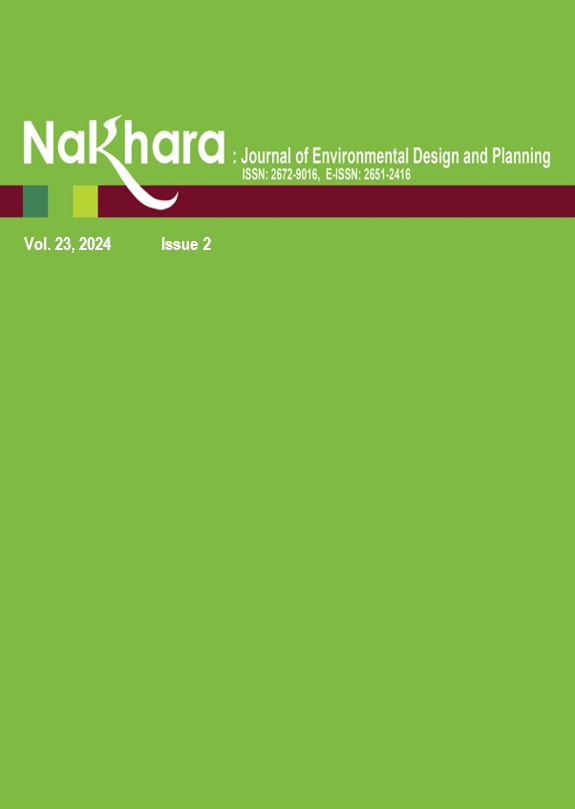Bamboo (Dendrocalamus Asper) as an Eco-Friendly Sustainable Material: Optimising Mechanical Properties and Enhancing Load-Bearing Capacity for Environmental Architectural Design
Main Article Content
Abstract
This study will assess the utilisation of Bamboo (a Thai vernacular material) in the construction industry. Bamboo is a sustainable and environmentally friendly material which provides a suitable alternative to traditional construction materials. This research will examine its mechanical strength properties as determined by a review of the existing literature and an examination of the bearing area variations of bamboo nodes.
The research data and ensuing experiments facilitated the simulation of the load-bearing capacities of bamboo columnar and beam structures via optimisation. Additionally, this study examined the limitations of bamboo-based structures. The assimilation of mechanical property data and bamboo strength was imperative for the production of load-bearing simulations for bamboo columns and beams within ANSYS software. In many countries, bamboo is a commonly employed construction material because of the many benefits it provides such as its rapid growth speed. The compressive strength tests conducted in this study revealed that the middle nodes could withstand up to 64.9 kN, which was the highest value amongs the three samples tested. These findings will contribute to ongoing optimisation and research regarding the damage mechanisms affecting column and beam structures under load. Notably, this damage was prevalent at the junctures of column and beam interfaces. The intention is to conduct additional research that will enhance the current understanding and ensure the sustainability of bamboo as an architectural building material.
Article Details

This work is licensed under a Creative Commons Attribution-NonCommercial-NoDerivatives 4.0 International License.
References
Abdel, H. (2020). Tea house / Pablo Luna Studio. ArchDaily. https://www.archdaily.com/984070/
tea-house-pablo-luna-studio?ad_medium=gallery
ArchDaily. (2014). Son la restaurant / VTN architects. ArchDaily. https://www.archdaily.com/559125/son-la-restaurant-vo-trong-nghia-architects?ad_medium=gallery
Archila-Santos, H. F., Ansell, M. P., & Walker, P. (2012). Low carbon construction using Guadua bamboo in Colombia. Key Engineering Materials, 517, 127–134. https://doi.org/10.1177/0021998314545182
Awoyera, P. O., & Adesina, A. (2017). Structural integrity assessment of bamboo for construction purposes. In S. Hashmi & I. A. Choudhury (Eds.), Reference Module in Materials Science and Materials Engineering (pp. 326–336). Elsevier. https://doi.org/10.1016/B978-0-12-803581-8.10366-2
Banjongrat, S. (2014). Mechanical properties of Thai structural bamboo for simple structure (Master’s thesis, Thammasat University). Thammasat University Digital Library. https://ethesisarchive.library.tu.ac.th/thesis/2014/TU_2014_5316030377_2249_1364.pdf
Chan-aek, C. (2021). Khrong Sang Mai Phai Sun Kanrianru Ngan Sathapattayakam Mai Phai [Bamboo structure, bamboo architecture learning center architectural]. Sripatum University.
Chaowana, K., Wisadsatorn, S., & Chaowana, P. (2021). Bamboo as a sustainable building material—Culm characteristics and properties. Sustainability, 13(13), Article 7376. https://doi.org/10.3390/su13137376
Chongtham, N. (2018). Identifying bamboos in the vegetative stage. Panjab University.
Forest Research Office. (n.d.). Kan Po̜ngkan Malæng Sattru Phut Tham Lai Mai Phai [Prevents insect pests from destroying bamboo]. Department of Forestry.
Institute for Lightweight Structure. (1985). IL 31 Bamboo-bambus. University of Stuttgart.
International Organization for Standardization. (2018). Bamboo — Determination of physical and mechanical properties (ISO 19624:2018). https://www.iso.org/standard/65528.html
Janssen, J. J. A. (2005). Building with bamboo (2nd ed.). ITDG Publishing. Júnior, A., Barreto, A., Rosa, D. S., Maia, J. N., Diego, L., & Mazzetto, S. E. (2014). Thermal and mechanical properties of biocomposites based on a cashew nut shell liquid matrix reinforced with bamboo fibers. Journal of Composite Materials, 42(2), 101–110. https://doi.org/10.1177/0021998314545182
Manandhar, R., Kim, J. H., & Kim, J. T. (2019). Environmental, social and economic sustainability of bamboo and bamboo-based construction materials in buildings. Journal of Asian Architecture and Building Engineering, 18(2), 49–59. https://doi.org/10.1080/13467581.2019.1595629
Manila, D. I. (n.d.). Making high-quality building materials with bamboo. Base-builds. https://base-builds.com/2023/05/19/from-harvesting-to-building-making-high-quality-building-materials-with-bamboo
Mena, J., Vera, S., Correal, J. F., & Lopez, M. (2012). Assessment of fire reaction and fire resistance of Guadua angustifolia Kunth bamboo. Construction and Building Materials, 27(1), 60–65. https://doi.org/10.1016/j.conbuildmat.2011.08.028
OoyWhan. (2015, October 7). Techniques for building a mud house: Weaving and filling soil. Bansuan Porpeang. https://www.bansuanporpeang.com/node/29180
Panin, T., & Mokkhasmita, T. (2021). Adaptive vernacular: A search for future houses in Eastern region of Thailand. Nakhara: Journal of Environmental Design and Planning, 20(2), Article 113. https://doi.org/10.54028/NJ202120113
Paridah, M. T. (2013). Bonding with natural fibres (1st ed.). Universiti Putra Malaysia Press.
Phakhiri, T. (1997). Physical and mechanical properties of bamboo [Master's thesis, Kasetsart University].
Sangsuwandee, K. (2019). Sathapattayakam Mai Phai Thai Prayuk: Rong Ræm Mai Phai [Applied Thai bamboo architecture: Bamboo hotel]. Sripatum University.
Schröder, S. (2024, September 14). Bamboos: Where does bamboo grow. Guaduabamboo. https://www.guaduabamboo.com/blog/where-does-bamboo-grow
Sharma, B., Gatoo, A., Bock, M., Mulligan, H., & Ramage, M. (2014). Engineered bamboo: State of the art. Proceedings of the ICE - Construction Materials, 167(1), 1–11. https://doi.org/10.1680/coma.13.00014
Solomon-Ayeh, K. A. (2005). Use of bamboo for buildings – A sustainable, strong, versatile and economic option for the preservation of timber in Ghana. Building and Road Research Institute (BRRI).
Thipudorn, S. (2016, November 7). Adhere to the principles of sufficiency economy: Selling basketry to create a living and make ends meet. Naewna. https://www.naewna.com/local/243439
Vada, P. (2018). Community center Camburi. ArchDaily. https://www.archdaily.com/906024/community-center-camburi-cru-architects?ad_medium=gallery
Vahanvati, M. (2015). The challenge of connecting bamboo. In 10th World Bamboo Congress. World Bamboo. https://www.worldbamboo.net/_files/ugd/9191d7_b98702530c0246dfb1810f9fc106c862.pdf
Wurianturi, I., Hasibuan, H. S., & Suganda, E. (2022). Optimizing open green space on urban campuses through the case of UI Salemba Campus: A step towards improved green metric ranking. Nakhara: Journal of Environmental Design and Planning, 21(3), Article 224. https://doi.org/10.54028/NJ202221224
Escamilla, Z. E., Habert, G., & Lopez Muñoz, L. F. (2014). Environmental savings potential from the use of Bahareque (mortar cement plastered bamboo) in Switzerland. Key Engineering Materials, 600, 21–33. https://doi.org/10.4028/www.scientific.net/KEM.600.21

